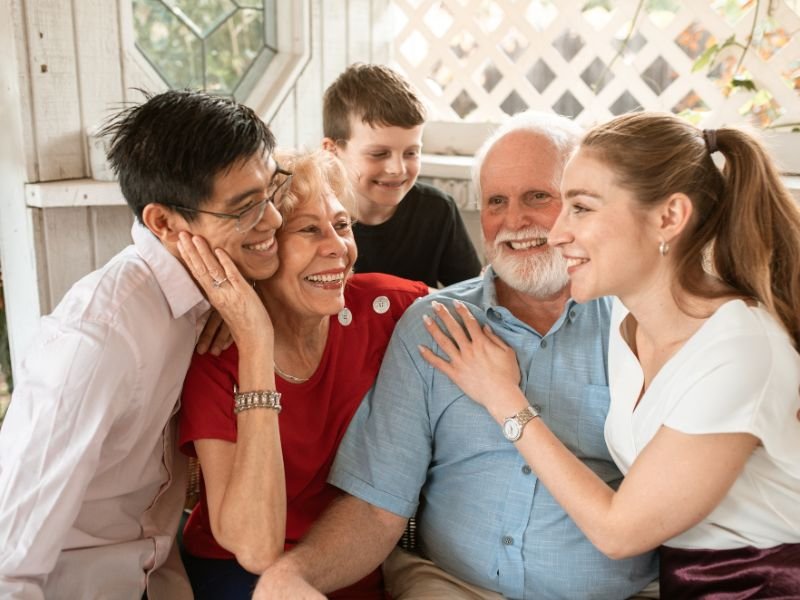Family-sponsored permanent residency in the United States serves as one of the primary avenues through which non-citizens can obtain lawful permanent resident (LPR) status, commonly known as a green card. This immigration pathway allows U.S. citizens and lawful permanent residents to petition for close family members to join them in the country as permanent residents.
The process is governed by U.S. immigration laws, which establish two major categories of family-based immigration: the immediate relatives of U.S. citizens and the family preference system. Immediate relatives, including spouses, unmarried children under 21, and parents of U.S. citizens aged 21 or older, benefit from an unlimited number of available visas. Meanwhile, the family preference system, which covers more distant relatives such as siblings and adult children, operates under annual numerical limits, often leading to extended waiting periods.
Family-Sponsored Permanent Residency In USA For Non-Citizens
The family-based immigration system plays a crucial role in fostering family reunification, a longstanding pillar of U.S. immigration policy. The United States has historically recognized the importance of keeping families together as a means of social and economic stability. Family reunification not only strengthens familial bonds but also contributes to the integration of immigrants into American society.
Many newly arrived immigrants rely on their family members for housing, employment opportunities, and cultural adaptation, which facilitates smoother transitions and enhances their ability to contribute to the U.S. economy. Through family sponsorship, the immigration system ensures that loved ones can support each other in building a stable and prosperous future in their adopted country.
Eligibility Categories
The U.S. immigration system classifies family-sponsored permanent residency applicants into two primary groups:
- 1. Immediate relatives of U.S. citizens
- 2. Family preference categories.
1. Immediate relatives of U.S. citizens
Immediate relatives of U.S. citizens benefit from a streamlined process, as they are not subject to annual visa quotas. This means that their applications can be processed as soon as they meet the eligibility and documentation requirements, making this category one of the fastest ways for non-citizens to obtain a green card. In contrast, the family preference system, which applies to more distant relatives, is subject to annual visa caps and extended waiting periods, often leading to years or even decades of delays.
Spouses
One of the most common ways for a non-citizen to gain permanent residency in the U.S. is through marriage to a U.S. citizen. A U.S. citizen can petition for their foreign-born spouse by filing Form I-130 (Petition for Alien Relative) with U.S. Citizenship and Immigration Services (USCIS). Since spouses fall under the immediate relative category, there is no cap on the number of visas issued each year. However, the application process requires strong evidence of a bona fide marriage, including joint financial records, photographs, and affidavits from friends and family to confirm the legitimacy of the relationship. Additionally, if the marriage is less than two years old at the time of obtaining a green card, the spouse will receive conditional permanent residency, requiring an additional petition two years later to remove conditions and obtain full permanent resident status.
Unmarried Children Under 21
U.S. citizens can also sponsor their unmarried children under the age of 21 for immediate permanent residency. Unlike other categories, these children do not have to wait for visa availability, allowing them to immigrate relatively quickly once their application is processed. This provision is particularly significant for families looking to keep young children close while they integrate into the educational and social framework of the U.S. If a child turns 21 before their green card is processed, they may fall into the F1 family preference category, which comes with a longer wait time due to annual visa limitations. The Child Status Protection Act (CSPA) provides some relief by allowing certain applicants to retain their classification as minors based on their age at the time of filing.
Parents of U.S. Citizens Aged 21 or Older
U.S. citizens who are at least 21 years old may petition for their parents to obtain permanent residency. Since parents also fall under the immediate relative category, there is no limit to the number of green cards issued in this category each year. To qualify, the sponsoring U.S. citizen must demonstrate a legitimate parent-child relationship and provide sufficient financial support through an Affidavit of Support (Form I-864) to ensure that the parent does not become a public charge. This option allows for the reunification of families, enabling parents to live with their adult children and access healthcare and other benefits available to permanent residents.
The immediate relative category remains the most advantageous family-based immigration option due to its lack of visa caps and quicker processing times. However, applicants must still meet stringent eligibility requirements, submit extensive documentation, and, in some cases, undergo an interview process to establish the legitimacy of their relationship with the U.S. citizen petitioner.
Family Preference Categories
Unlike immediate relatives of U.S. citizens, who are not subject to visa caps, individuals in the family preference categories must wait for a visa to become available based on annual limits set by U.S. immigration law. Each year, a fixed number of visas are allocated to these categories, often leading to significant backlogs and long processing times. The waiting period varies depending on the petitioner’s status, the applicant’s country of origin, and the specific preference category under which they qualify. These categories include unmarried adult children of U.S. citizens, spouses and children of lawful permanent residents, married adult children of U.S. citizens, and siblings of U.S. citizens.
F1: Unmarried Sons and Daughters (21 or Older) of U.S. Citizens
The F1 (First Preference) category is reserved for the unmarried adult sons and daughters (21 years or older) of U.S. citizens. Although they are close relatives of U.S. citizens, they do not qualify as immediate relatives and must wait for visa availability. The number of visas issued in this category is limited each year, and due to high demand, applicants from certain countries—such as Mexico, India, and the Philippines—often experience extended waiting periods. If an applicant gets married before receiving their visa, they automatically lose their F1 classification and must be reclassified under the F3 category, which has even longer wait times.
F2A: Spouses and Unmarried Children (Under 21) of Lawful Permanent Residents
The F2A category allows lawful permanent residents (green card holders) to sponsor their spouses and unmarried children under 21 for permanent residency. Unlike U.S. citizens, who can sponsor their spouses under the immediate relative category without numerical limits, permanent residents must wait for visa availability under this preference category. However, this category typically has shorter wait times compared to others in the family preference system. A significant advantage of the F2A category is that once the green card holder becomes a U.S. citizen, their spouse and children can be reclassified as immediate relatives, eliminating the visa backlog and expediting the process.
F2B: Unmarried Sons and Daughters (21 or Older) of Lawful Permanent Residents
The F2B category applies to unmarried adult sons and daughters (21 years or older) of lawful permanent residents. Unlike the F2A category, F2B applicants face longer waiting periods due to the limited number of visas available each year. This category is particularly important for green card holders who have older children living abroad and wish to reunite with them. However, if the petitioner becomes a U.S. citizen before the F2B applicant’s visa is issued, the petition can be upgraded to F1 status, which may or may not shorten the waiting time depending on visa availability. If the applicant marries, they become ineligible for the F2B category and must be reclassified under the F3 category for married sons and daughters of U.S. citizens.
F3: Married Sons and Daughters of U.S. Citizens
The F3 category is designated for married adult sons and daughters of U.S. citizens, along with their spouses and minor children. This category experiences some of the longest wait times in family-sponsored immigration due to the high demand and limited number of visas allocated each year. Applicants in this category must wait for their priority date to become current before they can proceed with their green card application. As with other categories, processing times vary depending on the applicant’s country of origin, with some cases taking more than a decade to finalize.
F4: Siblings of U.S. Citizens Aged 21 or Older
The F4 category allows U.S. citizens aged 21 or older to petition for their siblings to obtain permanent residency. This category includes the sibling’s spouse and minor children. Among all the family preference categories, the F4 category has the longest waiting times, often stretching over 15 years or more for applicants from countries with high demand, such as the Philippines, India, and Mexico. While this category offers an essential path to reunite extended family members, the long processing times make it one of the least efficient ways to immigrate to the United States.
Navigating the Family Preference System
Since family preference visas are subject to numerical limits, applicants must regularly check the Visa Bulletin, published monthly by the U.S. Department of State, to track their priority dates and estimate their wait times. Some applicants may explore alternative immigration pathways, such as employment-based visas or the Diversity Visa Lottery, while waiting for their family-sponsored green card to become available. Understanding the complexities of the family preference system is crucial for non-citizens seeking permanent residency through family sponsorship, as it allows them to make informed decisions about their immigration journey.
Application Process
The process of obtaining a family-sponsored green card involves multiple steps, from filing a petition to completing final visa processing. The complexity of the process depends on the applicant’s category, whether they are inside or outside the U.S., and the availability of visas based on annual limits. While immediate relatives of U.S. citizens typically experience shorter processing times, applicants in the family preference categories may face extended waiting periods due to visa backlogs.
Filing the Petition (Form I-130, Petition for Alien Relative)
The first step in the family-sponsored green card process is for a U.S. citizen or lawful permanent resident (green card holder) to file Form I-130, Petition for Alien Relative, with U.S. Citizenship and Immigration Services (USCIS). This form establishes the familial relationship between the sponsor and the beneficiary (the family member seeking a green card). The petitioner must provide supporting documents, such as birth certificates, marriage certificates, and proof of U.S. citizenship or permanent residency.
For immediate relatives, the approval of Form I-130 allows the beneficiary to proceed directly to visa processing or adjustment of status, depending on their location. However, for family preference categories, approval does not guarantee immediate visa availability—applicants must wait for a visa number based on annual caps.
Approval and Priority Date
Once USCIS approves the Form I-130 petition, the beneficiary is assigned a priority date, which is essentially their place in the visa queue. The priority date is based on the date the petition was filed and determines when the applicant can move forward with their green card process.
For immediate relatives of U.S. citizens, priority dates are current at all times, meaning there is no waiting period for visa availability. However, for applicants in family preference categories, priority dates are subject to visa caps and can result in waiting times ranging from several months to over 20 years, depending on the relationship category and the applicant’s country of origin.
Visa Bulletin and Waiting Periods
The Visa Bulletin, published monthly by the U.S. Department of State, provides updates on visa availability and helps applicants track their priority dates. Each Visa Bulletin lists cutoff dates for different family preference categories based on country of chargeability (typically the applicant’s country of birth). If an applicant’s priority date is earlier than the cutoff date listed in the Visa Bulletin, their visa is considered “current,” allowing them to proceed with their application.
As of February 2025, waiting times vary significantly:
- Immediate relatives (spouses, unmarried children under 21, and parents of U.S. citizens) face no visa backlog and can apply immediately.
- F1 (unmarried adult children of U.S. citizens) – Estimated wait times range from 6 to 10 years depending on the country.
- F2A (spouses and unmarried children under 21 of green card holders) – Historically current but subject to potential backlog due to high demand.
- F2B (unmarried adult children of green card holders) – Wait times range from 7 to 15 years for many applicants.
- F3 (married children of U.S. citizens) – Can take 12 to 20 years for visa availability, especially for applicants from Mexico and the Philippines.
- F4 (siblings of U.S. citizens) – Often the longest wait time, ranging from 15 to 25 years depending on the country.
Applicants should regularly check the Visa Bulletin to stay updated on their case status.
Consular Processing vs. Adjustment of Status
Once a visa becomes available, applicants must choose between two different final processing methods:
- Consular Processing (for applicants outside the U.S.)
- If the beneficiary is living outside the U.S., they must complete their immigration process through a U.S. embassy or consulate in their home country.
- After submitting required forms, paying fees, and attending a medical examination, they will be scheduled for an immigrant visa interview at the U.S. consulate.
- If approved, they will receive a visa and can enter the U.S. as a permanent resident.
- Once they arrive in the U.S., they will receive their green card in the mail within a few weeks.
- Adjustment of Status (Form I-485, for applicants in the U.S.)
- If the beneficiary is already in the U.S. on a valid visa, they may apply for adjustment of status (AOS) by filing Form I-485, Application to Register Permanent Residence or Adjust Status.
- This process allows applicants to remain in the U.S. while their application is processed, avoiding the need to return to their home country for visa approval.
- If an applicant is in the U.S. unlawfully, they may face legal complications and require a waiver of inadmissibility before proceeding.
- Upon approval, the applicant receives their green card without having to leave the U.S.
Key Considerations
- Immediate relatives can apply for adjustment of status immediately if they are already in the U.S.
- Family preference applicants must wait for their priority date to become current before applying for adjustment of status or consular processing.
- Applicants with unlawful presence in the U.S. may be subject to bars on re-entry and require special waivers.
Recent Policy Updates and Legal Developments
In August 2024, the Biden administration introduced the “Keeping Families Together” (KFT) parole process, aiming to provide undocumented spouses and stepchildren of U.S. citizens with a pathway to legal status. The initiative allowed eligible individuals present in the United States without admission or parole to apply for parole in place, provided they met specific criteria, including continuous physical presence since June 17, 2014, and the absence of any threats to public safety or national security.
The 2024 presidential election brought significant shifts in U.S. immigration policy. With the election of President Donald Trump in November 2024, the administration signaled intentions to tighten family-based immigration. Proposed changes include narrowing eligibility to immediate family members—primarily spouses and minor children—thereby potentially restricting pathways for extended family members such as parents, adult children, and siblings. These anticipated policy shifts could lead to increased scrutiny, longer processing times, and higher fees for family-based immigration applications.
The administration has expressed intentions to revive the Public Charge rule, which would restrict green card access for individuals deemed likely to become dependent on government assistance. Other proposed measures include ending birthright citizenship and enforcing ideological screenings for visa applicants. These developments underscore a broader strategy to limit both legal and illegal immigration, with significant implications for non-citizens seeking permanent residency through family sponsorship.
Required Documentation
Applying for family-sponsored permanent residency in the U.S. requires submitting extensive documentation to prove eligibility. The required documents vary based on the applicant’s relationship to the sponsor and whether they are applying from inside or outside the United States. Ensuring all documents are accurate and complete can prevent unnecessary delays in processing.
Proof of the Sponsor’s U.S. Citizenship or Permanent Residency
To establish eligibility, the petitioner (sponsor) must provide evidence of their U.S. citizenship or lawful permanent resident (LPR) status. Acceptable documents include:
- For U.S. Citizens:
- U.S. birth certificate
- U.S. passport (current and valid)
- Certificate of Naturalization (Form N-550 or N-570)
- Certificate of Citizenship (Form N-560 or N-561)
- Consular Report of Birth Abroad (Form FS-240)
- For Lawful Permanent Residents:
- Copy of their Permanent Resident Card (Green Card, Form I-551)
- Passport with an I-551 stamp (indicating LPR status)
- Re-entry permit (if applicable)
Providing accurate proof of status is crucial, as USCIS will reject petitions without proper documentation of the sponsor’s citizenship or residency.
Evidence of the Qualifying Family Relationship
To establish the family relationship between the petitioner and the beneficiary, specific supporting documents must be submitted with Form I-130, Petition for Alien Relative. The required documents depend on the nature of the relationship:
- Spouses:
- Marriage certificate
- Proof of joint finances (bank statements, leases, tax returns)
- Photographs together, travel records, or affidavits from friends and family confirming the legitimacy of the marriage
- If applicable, evidence of termination of prior marriages (divorce decree, annulment, or death certificate of former spouse)
- Parents and Children:
- Birth certificate listing the U.S. citizen or LPR as a parent
- If the petition is for an adopted child, official adoption records showing legal custody for at least two years before filing
- Siblings:
- Birth certificates for both the petitioner and beneficiary, showing at least one common parent
The burden of proof is on the petitioner to provide sufficient documentation to verify the legitimacy of the relationship. In cases where original documents are unavailable, alternative forms of evidence may be submitted along with an explanation.
Affidavit of Support (Form I-864)
To ensure that the immigrant will not become a public charge (dependent on government assistance), the sponsor must file Form I-864, Affidavit of Support. This legally binding document demonstrates that the petitioner has sufficient financial resources to support the beneficiary at 125% of the Federal Poverty Guidelines (100% for active-duty military sponsors petitioning for spouses or children). Required supporting documents include:
- Recent tax returns (typically the last three years)
- W-2 or 1099 forms
- Pay stubs or proof of income
- Bank statements
- Employment verification letter
If the sponsor does not meet the income requirements, a joint sponsor or household member can submit a separate Form I-864 to help meet the financial threshold.
Medical Examination and Vaccination Records
All applicants for family-sponsored permanent residency must undergo a medical examination conducted by a USCIS-approved civil surgeon (for applicants adjusting status in the U.S.) or a panel physician (for applicants undergoing consular processing). The medical exam is required to determine if the applicant has any communicable diseases, dangerous physical or mental disorders, or other health conditions that could render them inadmissible.
Applicants must submit Form I-693, Report of Medical Examination and Vaccination Record, which includes:
- Results of a physical exam
- Tuberculosis (TB) test results
- Proof of required vaccinations, including measles, mumps, rubella, polio, tetanus, hepatitis B, and others
- Screening for syphilis and gonorrhea (for applicants 15 and older)
The sealed medical examination report must be submitted to USCIS or provided during the consular interview, depending on the applicant’s immigration pathway.
Additional Required Documents (If Applicable)
- Police clearance certificates for applicants 16 years and older, if applying from outside the U.S.
- Court records for any criminal history, arrests, or prior immigration violations.
- Military records if the applicant has served in the armed forces of any country.
- Certified translations for any non-English documents submitted.
Completing and submitting the required documentation accurately is a crucial step in the family-sponsored immigration process. Failure to provide the necessary paperwork can lead to delays, requests for additional evidence (RFEs), or even denials. Ensuring that all documentation is in order before filing can help streamline the process and increase the likelihood of approval.
Common Challenges and Considerations
Applying for family-sponsored permanent residency in the U.S. can be a complex and time-consuming process, often influenced by external factors such as visa availability, policy changes, and legal challenges. Applicants must be prepared for potential obstacles and remain informed to navigate the system effectively.
Potential Delays Due to Visa Backlogs
One of the most significant challenges in family-based immigration is the backlog of visa applications, particularly in the family preference categories. Since each preference category is subject to annual numerical limits, applicants often face long wait times, sometimes spanning decades. For instance, siblings of U.S. citizens under the F4 category may wait 15 to 25 years before a visa becomes available, depending on their country of origin. Countries with high demand, such as Mexico, India, and the Philippines, often experience the longest delays. Applicants must track their priority dates through the Visa Bulletin and plan accordingly to avoid missing deadlines when their visas become available.
Impact of Legal Challenges on Immigration Programs
U.S. immigration policy is subject to frequent legal and political changes, which can significantly impact family-sponsored green card applications. Programs like the “Keeping Families Together” initiative, which aimed to provide relief for undocumented spouses of U.S. citizens, were halted due to legal challenges in federal courts. Similarly, past administrations have introduced public charge rules and increased scrutiny on visa applicants, delaying the processing of applications. As new policies emerge and existing ones face legal challenges, applicants must stay updated on their rights and any potential changes that may affect their cases.
Importance of Staying Informed About Policy Changes
Given the shifting nature of U.S. immigration policy, staying informed is crucial for family-sponsored applicants. Changes in administration often bring modifications to visa processing times, eligibility requirements, and enforcement priorities. For example, the 2024 presidential election has led to new discussions about restricting family-based immigration, potentially limiting which relatives can be sponsored for green cards. Applicants should regularly check official sources such as USCIS, the Department of State, and legal advocacy organizations to ensure they have the latest information. Consulting with an immigration attorney can also help families prepare for any unexpected legal or procedural challenges.
As the United States navigates the evolving immigration system in 2025, understanding the nuances of family-sponsored permanent residency remains essential for those seeking to reunite with their loved ones while complying with the legal requirements of the process. While the process of obtaining a family-sponsored green card can be lengthy and complex, careful planning, patience, and staying informed can help applicants navigate challenges and achieve successful outcomes.
Despite the challenges, family reunification remains a fundamental pillar of U.S. immigration, offering millions the opportunity to build a stable and secure future with their loved ones. By staying proactive, informed, and well-prepared, applicants can maximize their chances of successfully obtaining permanent residency in the United States.






